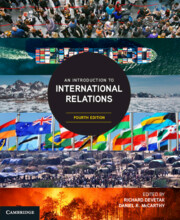Book contents
- Frontmatter
- Contents
- Tables, figures and boxes
- Contributors
- Preface and acknowledgements
- Guide to online instructor resources
- Introduction: The origins and changing agendas of international relations
- Part 1 Theories of International Relations
- Chapter 1 International Relations theory in an age of critical diversity
- Chapter 2 Liberalism
- Chapter 3 Realism
- Chapter 4 Marxism and critical theory
- Chapter 5 Feminism
- Chapter 6 Postmodernism
- Chapter 7 Constructivism
- Chapter 8 Postcolonialism
- Part 2 International history
- Part 3 The traditional agenda: States, wars and law
- Part 4 The new agenda: Globalisation and global challenges
- References
- Index
- Figure and text acknowledgements
Chapter 6 - Postmodernism
from Part 1 - Theories of International Relations
Published online by Cambridge University Press: aN Invalid Date NaN
- Frontmatter
- Contents
- Tables, figures and boxes
- Contributors
- Preface and acknowledgements
- Guide to online instructor resources
- Introduction: The origins and changing agendas of international relations
- Part 1 Theories of International Relations
- Chapter 1 International Relations theory in an age of critical diversity
- Chapter 2 Liberalism
- Chapter 3 Realism
- Chapter 4 Marxism and critical theory
- Chapter 5 Feminism
- Chapter 6 Postmodernism
- Chapter 7 Constructivism
- Chapter 8 Postcolonialism
- Part 2 International history
- Part 3 The traditional agenda: States, wars and law
- Part 4 The new agenda: Globalisation and global challenges
- References
- Index
- Figure and text acknowledgements
Summary
This chapter offers an account of postmodernism. It begins by drawing a distinction between two broad approaches to the postmodern: one that outlines the contours of a new historical period (postmodernity), and another that places emphasis on finding new ways of understanding modern practices of knowledge and politics (postmodernism). The second part of the chapter examines how postmodern ideas entered international relations scholarship, and how ensuing contributions continue to reveal important insights up to the present day. Defining postmodernism is no easy task. Postmodern scholarship is characterised more by diversity than by a common set of beliefs. Add to this that the postmodern has become a very contentious label, which is used less by its advocates and more by polemical critics who fear that embracing postmodern values would throw us into a dangerous nihilist void. But while the contours of the postmodern will always remain elusive and contested, the substantial issues that the respective debates have brought to the fore are important enough to warrant attention.
Keywords
- Type
- Chapter
- Information
- An Introduction to International Relations , pp. 83 - 94Publisher: Cambridge University PressPrint publication year: 2024



